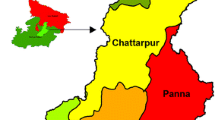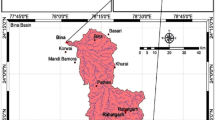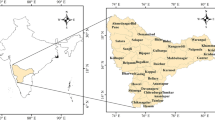Abstract
Decision makers face multifaceted challenge in characterizing drought climatology for appropriate water resources-related drought management strategies. This paper focuses on understanding and quantifying the drought vulnerability of Bearma basin in the Bundelkhand region of central India, which is one of the prominent climate extremes that the region is affected by frequently. Regular drought conditions have been prevailing in the region in the last decade with continuous drought from 2004 to 2007. An integrated approach using multiple indicators has been developed to spatially identify the vulnerable regions. The Bearma basin has been selected as a pilot basin to develop a methodology for integrated drought vulnerability assessment adopting spatially and temporally varying drought characteristics represented by drought indicators. The temporally varying indicators include standardized precipitation index (SPI), surface water drought index and groundwater drought index. The spatial information of the indicators was categorized in layers prepared in the spatial domain using a geographic information system, and integrated values of weights of various indicators have been computed on a 50 × 50 m grid scale. The SPI has been applied to quantify monthly precipitation deficit anomalies on multiple time scales (1, 3, 6 and 12 months). The drought characteristics including frequency, duration and intensity and magnitude have been calculated with the estimated SPI. The multiple indicator approach has been used for arriving at the drought vulnerable zones. The highly vulnerable areas are located in the southern and northern regions of the Bearma basin. It has been observed that more than 26 % of the basin lies in the highly and critically vulnerable classes and consequently has greater drought-related negative impacts. Results show that the proposed method is highly effective in representing assessments of drought vulnerability.












Similar content being viewed by others
References
Adger WN (2006) Vulnerability. Global Environ Change 16(3):268–281
Adger WN, Huq S, Brown K, Conway D, Hulme M (2002) Adaptation to climate change: setting the agenda for development policy and research. Tyndall centre for climate change, research working paper 16
Appa Rao G (1986) Drought climatology, Jal Vigyan Samiksha, Publication of high level technical committee on hydrology, National Institute of Hydrology, Roorkee
Babaei H, Araghinejad S, Hoorfar A (2013) Developing a new method for spatial assessment of drought vulnerability (case study): zayandeh-Rood river basin in Iran). Water Environ J 27:50–57
Baethgen WE (1997) Vulnerability of the agricultural sector of Latin America to climate change. Climate Research 9(1–2):1–7
Bernstein L et al (2007) Climate change 2007: synthesis report. Cambridge University Press, Cambridge, p 104
Burton I, Huq S, Lim B, Pilifosova O, Schipper EL (2002) From impacts assessment to adaptation priorities: the shaping of adaptation policies. Clim Policy 2:145–159
Cutter SL (1996) Vulnerability to environmental hazards. Prog Hum Geogr 20(4):529–539
Cutter SL, Boruff BJ, Shirley WL (2003) Social vulnerability to environmental hazards. Social Sci Q 84(2):242–261
Dai A, Trenberth KE, Qian T (2004) A global data set of palmer drought severity index for 1870–2002: relationship with soil moisture and effects of surface warming. J Hydrometeorol 5:1117–1130
Descroix L, Vauclin M, Viramontes D, Esteves M, Barrios JLG, Anaya E (2003) Water management in Northern Mexico: sharing resources affected by drought. Houille Blanche-Revue Internationale De L Eau 6:46–52
Dougil AJ, Fraser EDG, Reed MS (2010) Anticipating vulnerability to climate change in dryland pastoral systems: using dynamic systems models for the Kalahari. Ecol Soc 15(2):17
Downing TE, Bakker K (2000) Drought discourse and vulnerability, Chapter 45. In: Wilhite DA (ed) Drought: a global assessment, natural hazards and disaster series. Routledge publishers, UK
Downing TE, Butterfield R, Cohen S, Huq S, Moss R, Rahman A, Sokona Y, Stephen L (2001a) Vulnerability indices: climate change impacts and adaptation, UNEP Policy Series, UNEP, Nairobi
Downing TE, Butterfield R, Cohen S, Huq S, Moss R, Rahman A, Sokona Y, Stephen L (2001b) Climate change vulnerability: linking impacts and adaptation. Oxford University Press, Oxford
Eakin H, Conley J (2002) Climate variability and the vulnerability of ranching in southeastern Arizona: a pilot study. Clim Res 21(3):271–281
Edward EC, Mckee TB (1997) Characteristics of 20th century drought in the United State at multiple time scales, Paper No. 634, Climatology Report No. 97-2 Colorado state university, 155
Fraser EDG, Dougill AJ, Hubacek K, Quinn CH, Sendzimir J, Termansen M (2011) Assessing vulnerability to climate change in dryland livelihood systems: conceptual challenges and interdisciplinary solutions. Ecol Soc 16(3):3
Gogu RC, Dassargues A (2000) Current trends and future challenges in groundwater vulnerability assessment using overlay and index methods. Environ Geol 39(6):549–559
Hayes M, Svoboda M, Wall N, Widhalm M (2010) The Lincoln declaration on drought indices: universal meteorological drought index recommended. Am Meteorol Soc 92(4):485–488
Hewitt K (1997) Regions at risk. A geographical introduction to disasters. Addison Wesley Longman Limited, England
Ionescu C, Klein RJT, Hinkel J, Kumar KSK, Klein R (2005) Towards a formal framework of vulnerability to climate change. Environ Model Assess 14(1):1–16
IPCC (2001) Climate change 2001: impacts, adaptation and vulnerability, summary for policymakers, WMO
Keenan SP, Krannich RS (1997) The social context of perceived drought vulnerability. Rural Sociol. 62(1):69–88
Keyantash J, Dracup JA (2002) The quantification of drought: an evaluation of drought indices. B Am Meteorol Soc 83(8):1167–1180
Khoshnodifar Z, Sookhtanlo M, Gholami H (2012) Identification and measurement of indicators of drought vulnerability among wheat farmers in Mashhad County, Iran. Ann Biol Res 3(9):4593–4600
Kogan FN (1997) Global drought watch from space. Bull Am Meteor Soc 78(4):621–636
Kogan FN (2000) Global drought detection and impact assessment from space. Drought Glob Asses 1:196–210
Lilibeth A, Eierdanz F, Alcamo J, Krömker D, Galli F, Klein RJT, Kavi Kumar KS, Campe S, Carius A, Tänzler D (2006) An empirical application of the security diagram to assess the vulnerability of india to climatic stress. Clim Change Human Sec 137(3):199–219
Luers AL, Lobell DB, Sklar LS, Addams CL, Matson PA (2003) A method for quantifying vulnerability, applied to the agricultural system of the Yaqui Valley, Mexico. Global Environ Change 13(4):255–267
McKee TB, Doesken NJ, Kleist J (1993) The relationship of drought frequency and duration to time scales. In Proceedings eighth conferences on applied climatology, Anaheim, CA, Am Meteor Soc, 179–186
McKee TB, Doesken NJ, Kleist J (1995) Drought monitoring with multiple time scales, Preprints, 9th conference on applied climatology, January 15–20, Dallas, Texas, pp 233–236
Nalbantis Ι (2008) Drought and stream flow. Eur Water 23(24):65–76
Nalbantis Ι, Tsakiris G (2009) Assessment of hydrological drought revisited. Water Resour Manage 23(5):881–897
Naumann G, Barbosa P, Garrote L, Iglesias A, Vogt J (2014) Exploring drought vulnerability in Africa: an indicator based analysis to be used in early warning systems. Hydrol Earth Syst Sci 18:1591–1604
Pandey RP, Pandey A, Galkate RV, Byun H, Mal BC (2010) Integrating hydro-meteorological and physiographic factors for assessment of vulnerability to drought. Water Resour Manage 24:4199–4217
Shukla S, Wood AW (2008) Use of a standardized runoff index for characterizing hydrologic drought. Geophys Res Lett L02405(35):1–7. doi:10.1029/2007GL032487
Sims AP, Niyogi DDS, Raman S (2002) Adopting drought indices for estimating soil moisture: a North Carolina case study, Geophys Res Lett 29(10):241–244
Tabari H, Nikbakht J, Hosseinzadeh Talaee P (2013) Hydrological drought assessment in northwestern Iran based on streamflow drought index (SDI). Water Resour Manage 27(1):137–151
Thomas T, Nayak PC, Ghosh N (2015a) Spatiotemporal analysis of drought characteristics in the Bundelkhand region of Central India using the Standardised Precipitation Index, ASCE J Hydrologic Engineering, 10.1061(ASCE)HE, 1943-5584.0001189
Thomas T, Gunthe SS, Ghosh NC, Sudheer KP (2015b) Analysis of monsoon rainfall variability over Narmada basin in Central India: implication of climate change. J Water Clim Change 06(3):615–627
Turner BL, Kasperson RE, Matson PA, McCarthy JJ, Corell RW, Christensen L, Eckley N, Kasperson JX, Luers A, Martello ML, Polsky C, Pulsipher A, Schiller A (2003) A framework for vulnerability analysis in sustainability science. Proc Natl Acad Sci USA 100(14):8074–8079
Villa F, McLeod H (2002) Environmental vulnerability indicators for environmental planning and decision-making: guidelines and applications. Environ Manage 29(3):335–348
Wilhelmi OV, Wilhite DA (2002) Assessing vulnerability to agricultural drought: a Nebraska case study. Nat Hazards 25(1):37–58
Wilhelmi OV, Hubbard KG, Wilhite DA (2002) Spatial representation of agro-climatology in a study of agricultural drought. Int J Climatol 22:1399–1414
Wilhite DA (1993) The enigma of drought, Chapter 1. In: Wilhite DA (ed) Drought assessment, management, and planning: theory and case studies. Kluwer Academic Publishers, Boston, pp 3–17
Wilhite DA (2000) Drought as a natural hazard: concept and definition. In: Wilhite Donalt A (ed) Drought: a global assessment, natural hazards and disaster series, vol 1. Routledge Publisher, UK
Zamani R, Tabari H, Willems P (2015) Extreme stream flow drought in the Karkheh river basin (Iran): probabilistic and regional analyses. Nat Hazards 76:327–346
Zarafshani KK, Sharafi L, Azadi H, Hosseininia G, Maeyer PD, Witlox F (2012) Drought vulnerability assessment: the case of wheat farmers in Western Iran. Global Planet Change 98–99:122–130
Author information
Authors and Affiliations
Corresponding author
Rights and permissions
About this article
Cite this article
Thomas, T., Jaiswal, R.K., Galkate, R. et al. Drought indicators-based integrated assessment of drought vulnerability: a case study of Bundelkhand droughts in central India. Nat Hazards 81, 1627–1652 (2016). https://doi.org/10.1007/s11069-016-2149-8
Received:
Accepted:
Published:
Issue Date:
DOI: https://doi.org/10.1007/s11069-016-2149-8




